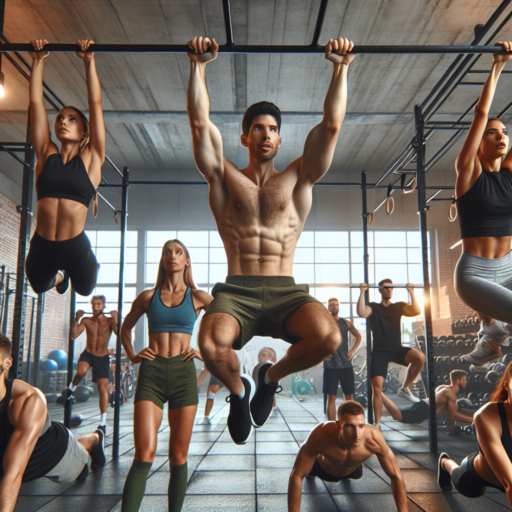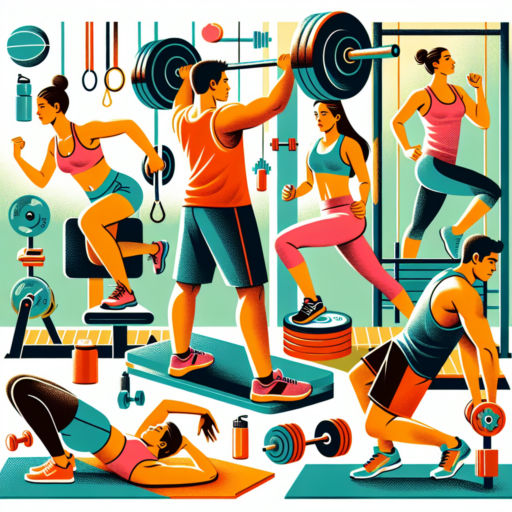Introduction to Upper Body Calisthenics Workouts for Intermediates
Embarking on upper body calisthenics workouts as an intermediate practitioner represents a pivotal stage in your fitness journey. Unlike beginners who are just getting familiar with the basics, intermediates are ready to challenge their muscles with increased intensity and complexity. These workouts, which leverage your body weight for resistance, are excellent for sculpting a strong, functional upper body without the need for gym equipment. This stage encourages not only physical growth but also mental resilience, as exercises become more demanding.
Calisthenics exercises for the upper body primarily target the chest, back, shoulders, and arms. However, the beauty of these routines lies in their holistic approach, often engaging multiple muscle groups simultaneously. This interconnectedness ensures a balanced development of strength and muscles, enhancing your overall physical capabilities. Additionally, as you progress, you’ll find opportunities to refine your technique, a crucial aspect for intermediates aiming to maximize gains while minimizing injury risks.
Progressing in calisthetics can at times seem daunting due to the increased demand on both your muscular and neurological systems. Engaging in a well-structured upper body calisthenics program is key. Not only will this provide the necessary challenges to stimulate muscle growth and endurance, but it will also ensure you’re advancing safely and efficiently. Embracing this journey requires dedication, patience, and a willingness to step out of one’s comfort zone, characteristics that define the intermediate level.
Top 5 Upper Body Calisthenics Exercises for Intermediate Levels
Calisthenics exercises are an effective way to build strength and muscle without the need for equipment. Intermediate-level practitioners often look for ways to push their limits and achieve greater strength and definition in their upper bodies. The following exercises are ideal for those who have surpassed the basics and are ready to challenge themselves further.
Pull-Ups
Widely regarded as one of the most effective upper body exercises, pull-ups primarily target the back muscles, biceps, and forearms. By adjusting your grip width and hand position, you can focus on different muscle groups, making pull-ups a versatile addition to your routine.
Dips
Dips are another powerhouse exercise that focuses on the triceps, chest, and shoulders. Their intense nature pushes your muscles to adapt and grow, making dips essential for those aiming to enhance their upper body strength.
Push-Ups
While often considered a beginner exercise, push-ups can be significantly intensified for intermediate levels. Variations such as diamond push-ups, archer push-ups, and pseudo planche push-ups drastically increase the difficulty, challenging your chest, shoulders, and triceps.
Handstand Push-Ups
Handstand push-ups take the traditional push-up to new heights—literally. This exercise demands not only strength but also a good balance and core stability, targeting your shoulders, upper back, and arms. It is a true test of upper body prowess and control.
Front Lever Raises
Last but not least, front lever raises are one of the more challenging calisthenics exercises that primarily work the core but also greatly engage the lats, shoulders, and arms. Mastering this exercise indicates a high level of strength and control over one’s body.
Step-by-Step Guide to Perfecting Your Intermediate Upper Body Calisthenics Routine
Embarking on an intermediate upper body calisthenics routine offers an excellent opportunity to sharpen your fitness levels while sculpting your physique without the need for equipment. This guide will delve into the key components necessary for enhancing your routine, ensuring you make the most of every push-up, dip, and pull-up. Remember, consistency and proper form are paramount in your journey toward calisthenics mastery.
Optimizing Your Form for Efficiency
Before diving deep into advanced techniques, refining your form is crucial. Intermediate routines demand more from your body, making it imperative to focus on precision and alignment. For pull-ups, ensure your grip is slightly wider than shoulder-width apart, activating your lats, biceps, and shoulders effectively. When tackling push-ups, maintain a straight line from your head to your heels, enhancing core engagement and tricep activation. These minor adjustments can significantly amplify your strength and endurance over time.
Incorporating Variations to Challenge Your Muscles
To avoid hitting a plateau, integrating variations into your routine is essential. Alternating between different forms of push-ups (such as diamond, archer, or explosive push-ups) can target various muscle groups, promoting balanced growth and preventing overuse injuries. Similarly, experimenting with grip variations in pull-ups and dips can introduce new challenges, ensuring your muscles do not become too accustomed to the same movements, thereby fostering continuous improvement and strength gains.
Creating a Progressive Overload Plan
Progressive overload is the cornerstone of advancing in your calistics journey. Gradually increasing the intensity of your workouts by incorporating more reps, adding weight vests, or executing more complex movements ensures consistent progress. Start by setting realistic goals, such as increasing your maximum pull-ups or dips by one every week, and track your achievements. This structured approach keeps you motivated while systematically pushing your boundaries further.
How to Progress in Your Upper Body Calisthenics Journey as an Intermediate
Reaching the intermediate stage in your upper body calisthenics journey marks a significant milestone. However, progressing further requires a blend of perseverance, strategic planning, and a deeper understanding of your body’s capabilities and limitations. At this stage, refinement of technique, incremental difficulty, and variation become pivotal for fostering growth, strength, and endurance.
Refining Techniques and Form
As you transition from beginner to intermediate, the focus must shift towards refining the foundational movements you’ve learned. This is not merely about executing movements but enhancing them for efficiency and effectiveness. Take, for example, push-ups and pull-ups; ensuring that every rep is performed with perfect form can significantly increase muscle activation and growth. Additionally, consider video recording your sessions or seeking feedback from experienced practitioners to correct any form discrepancies.
Incorporating Progressive Overload
To continue the trajectory of growth, it’s essential to introduce the concept of progressive overload into your regimen. This doesn’t necessarily mean increasing the number of reps indiscriminately. Instead, focus on alternative methods to make exercises more challenging, such as elevating your feet during push-ups or adding a weight vest for pull-ups. Progressive overload keeps your muscles under tension for longer periods, inducing hypertrophy and improving stamina.
Remember, progression in upper body calisthenics as an intermediate relies heavily on patience, experimentation, and listening to your body. Advance incrementally, prioritize recovery, and don’t shy away from challenges that push your boundaries. This thoughtful approach will pave the way for continued improvement and mastery over your calisthenics skills.
Common Mistakes to Avoid in Intermediate Upper Body Calisthenic Workouts
When advancing to intermediate upper body calisthenic workouts, enthusiasts often encounter specific pitfalls that can hinder progress and lead to injuries. Recognizing and steering clear of these mistakes is imperative for continuous improvement and maintaining a healthy training regimen. Below, we will delve into some of the most common missteps and how to avoid them.
Overlooking Proper Warm-Up and Cool-Down Routines
One significant error is skipping the essential warm-up and cool-down phases. A thorough warm-up increases blood flow to the muscles, preparing them for the strenuous activity ahead, while a proper cool-down helps to gradually lower the heart rate and start the recovery process. Incorporating dynamic stretches and lightweight exercises at the start, followed by static stretching post-workout, can markedly diminish the risk of injury and improve overall performance.
Ignoring Proper Form and Technique
Another critical mistake is neglecting the importance of maintaining proper form and technique throughout each exercise. In the quest to achieve more reps or handle more advanced movements, the fundamental aspect of correct form can be lost, leading to ineffective workouts or worse, injury. To prevent this, focus on executing each exercise with precision, and consider recording your sessions or working with a fitness professional to gain valuable feedback on your technique.
Failing to Implement a Balanced Workout Routine
Lastly, an unbalanced workout plan that overly concentrates on certain muscle groups while neglecting others can lead to muscular imbalances and postural issues. A well-rounded approach that targets all major muscle groups of the upper body—such as the chest, back, shoulders, and arms—is crucial. Incorporating a variety of exercises and progressively challenging the muscles with increased resistance or complexity ensures balanced development and minimizes the risk of overuse injuries.
Essential Tips for Mastering Intermediate Upper Body Calisthenics Movements
Mastering intermediate upper body calisthenics movements is a pivotal step for those looking to elevate their physical fitness through bodyweight exercises. At this stage, it’s critical to focus on technique, consistency, and progressive overload to ensure continuous improvement and prevent injury. Here, we delve into some essential tips that are cornerstone to advancing your calisthenics skills beyond the basics.
Refine Your Technique with Precision
At the heart of calisthenics is the execution of movements with impeccable technique. For intermediate practitioners, it’s vital to concentrate on the precision of each exercise. Begin by revisiting the fundamentals of push-ups, pull-ups, and dips. Ensure that your form is perfect by recording yourself or seeking feedback from seasoned athletes. Paying close attention to hand positioning and movement fluidity can dramatically improve your strength and efficiency, setting a robust foundation for more complex movements.
Incorporate Progressive Overload
To advance in upper body calisthenics, integrating progressive overload into your routine is indispensable. This can be achieved by increasing the reps, adding more challenging variations, or wearing a weighted vest. For instance, transitioning from regular push-ups to archer push-ups or introducing typewriter pull-ups into your repertoire challenges your muscles in new ways, promoting growth and adaptability. Remember, the key is to push your boundaries gradually while maintaining optimal form.
No se han encontrado productos.
Upper Body Calisthenics Workout Plan for Intermediate Practitioners
Embarking on an upper body calisthenics workout plan can mark a significant progression in the strength and agility of intermediate practitioners. Calisthenics, known for its simplicity and reliance on body weight for resistance, offers a versatile pathway to build muscle without the need for heavy gym equipment. Intermediate practitioners can expect to refine their technique, increase their strength, and develop a more pronounced muscle definition by adhering to a structured workout designed specifically for the upper body.
The journey towards mastering upper body calisthenics begins with understanding the right mix of exercises that target the chest, shoulders, back, and arms. Incorporating variations of push-ups, pull-ups, and dips, while progressively increasing the intensity, ensures a comprehensive engagement of all upper body muscle groups. This strategic progression challenges the muscles, prompting adaptation and growth, which are crucial for intermediate practitioners aiming to advance to more complex calisthenics movements.
Equally important is the integration of rest and recovery days within the workout plan. Muscles need time to repair and grow stronger, making rest an essential component of any training regimen. For holistic development and to prevent injury, intermediate practitioners should balance their workout days with adequate recovery, ensuring they are giving their body the essential time it needs to adapt and strengthen after each rigorous session. By maintaining this balanced approach, enthusiasts can steadily work towards achieving their upper body strength and aesthetics goals through calisthenics.
Incorporating Equipment into Your Intermediate Upper Body Calisthenics Workouts
Taking your intermediate upper body calisthenics workouts to the next level might involve incorporating some key pieces of equipment. Using the right tools can not only enrich your routine but also bring a fresh challenge and help you overcome plateaus. Whether you’re aiming to increase muscle size, strength, or endurance, the strategic addition of equipment can cater to all these goals.
Choosing the Right Equipment for Enhanced Performance
Selecting the right equipment is crucial for maximizing the benefits of your workouts while minimizing the risk of injury. Some popular choices include pull-up bars, resistance bands, and weighted vests. A pull-up bar allows for a variety of grip positions, each targeting different muscle groups. Resistance bands offer adjustable tension, making exercises more challenging as you progress. Meanwhile, weighted vests distribute additional weight evenly, increasing the intensity of bodyweight exercises.
Integrating Equipment into Your Routine
Incorporating equipment into your calisthenics regimen should be done gradually to allow your body to adjust. Begin with lighter weights or lower resistance levels and progressively increase as you become more comfortable. For instance, start your pull-up sessions using bands for assisted pull-ups if you’re working on building strength. As for adding complexity, try incorporating dynamic movements like clap pull-ups or muscle-ups once you’re proficient in basic pull-ups. This approach ensures continuous improvement and helps in achieving a well-rounded upper body strength.
Navigating through the plethora of upper body calisthenics workouts with added equipment might seem daunting at first. Yet, focusing on exercises that align with your fitness goals and progressively challenging yourself with the right equipment can propel your workouts to new heights. Remember, consistency and proper technique are key to unlocking the full potential of your upper body routine.
Measuring Progress and Setting Goals in Upper Body Calisthenics for Intermediates
When advancing in the realm of upper body calisthenics, intermediates face the crucial task of accurately measuring their progress and effectively setting their fitness goals. Enhancing your strength, endurance, and skill level requires a strategic approach to tracking your development. This throughline is not simply about performing more repetitions but understanding the nuances of progress in calisthenics.
One beneficial method for intermediates is to maintain a detailed workout log. This can include notes on exercise routines, variations attempted, and personal reflections on each session’s difficulty. Over time, this log will showcase your progression in terms of both volume and complexity of calisthenic exercises. Furthermore, setting SMART (Specific, Measurable, Achievable, Relevant, and Time-bound) goals can systematically guide your training regimen, ensuring gradual and consistent enhancements.
To comprehensively measure progress, involving qualitative assessments alongside quantitative metrics is essential. This means not just counting reps or sets, but also paying attention to form, technique, and the ease with which exercises are performed. Incorporating video recordings of practice sessions for self-assessment or feedback from a coach or community can provide invaluable insights into where improvements can be made.
FAQs: Upper Body Calisthenics Workout for Intermediate Levels
When advancing to intermediate levels in calisthenics, enhancing your upper body strength and technique is pivotal. Here, we address some of the most frequently asked questions regarding upper body calisthenics workout routines for intermediate practitioners.
What Are the Best Upper Body Calisthenics Exercises for Intermediates?
Intermediate level calisthenics involves a mixture of complexity and strength building. Some top exercises include pull-ups, dips, and push-ups with variations like archer pull-ups and ring dips. Incorporating these exercises into your routine can significantly improve strength, endurance, and muscle definition.
How Often Should Intermediate Practitioners Train the Upper Body?
The frequency of training is crucial for balanced growth and recovery. For intermediates, a schedule of 3-4 days a week specifically for upper body workouts is recommended. It’s important to allow muscles time to recover and grow, thus avoiding the risk of overtraining and injury.
Are Supplements Necessary for Intermediate Calisthenics Training?
While not entirely necessary, certain supplements can aid in recovery and performance. For instance, protein supplements can assist in muscle repair, while creatine might improve strength and performance during high-intensity workouts. However, a well-balanced diet is paramount and should be the foundation of your nutritional intake.




